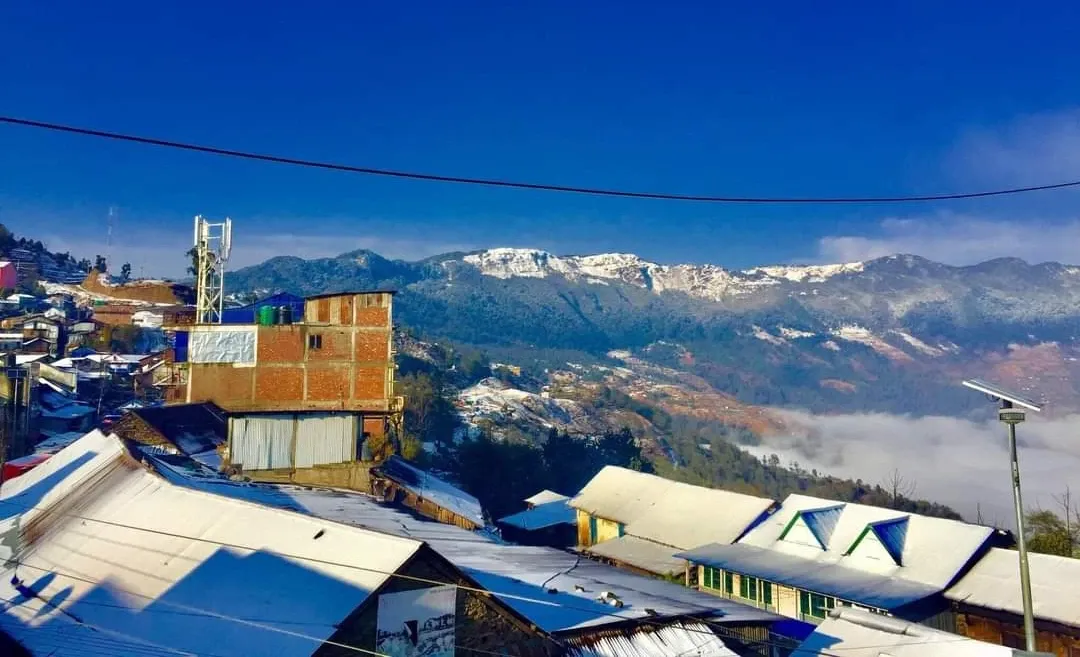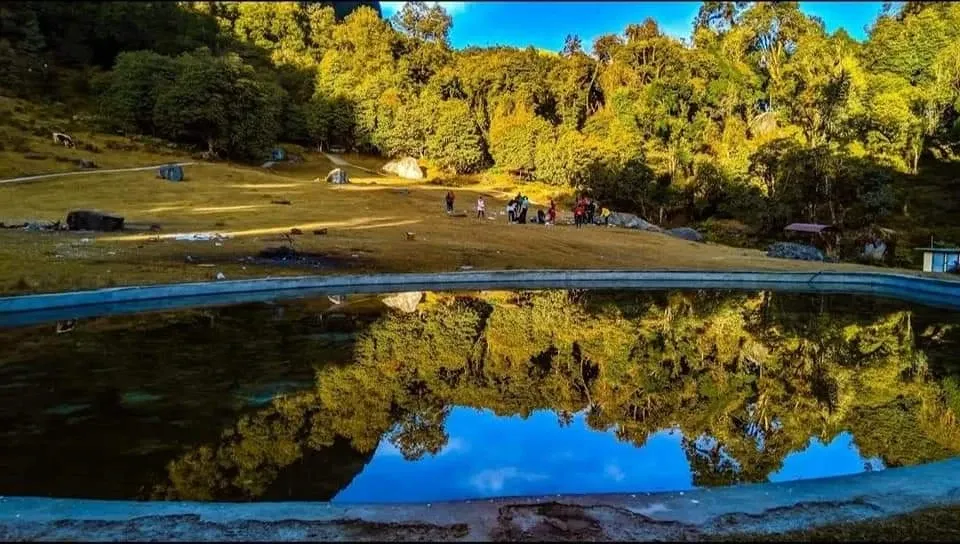Terathum: TMJ and Panchakanya pokhari
Basantapur Tinjure Milke & Jaljale" ("TMJ")
In the Yakthung language: Sumhalung,Milagu,Sumbalung/Sumbhetlung) with Panchakanya Pokhari
Synopsis: Nestled in the Tehrathum District of Eastern Nepal, Basantapur is a picturesque gateway to the trekking routes of Sankhuwasabha, Taplejung, and the Kanchenjunga region. This article explores the enchanting landscapes of Basantapur, Tinjure, Milke, Jaljale (TMJ), and Panchakanya Pokhari, showcasing their natural beauty, diverse flora and fauna, and rich cultural heritage. From the rhododendron forests of Tinjure to the highest waterfall in Jaljale and the cultural significance of Panchakanya Pokhari, TMJ offers a unique blend of trekking adventures and cultural immersion. The area's festivals, traditions, and myths add depth to its natural allure, making TMJ a captivating destination for travelers seeking to explore the marvels of Eastern Nepal.
Introduction
Nestled in the Tehrathum District of the Eastern region in the Koshi zone, Province No. 1, lies the enchanting destination of Basantapur. Standing tall at an elevation of approximately 2,200 meters above sea level, Basantapur serves as a gateway to the trekking routes leading to Sankhuwasabha, Taplejung, and the illustrious Kanchenjunga region.
This article takes you on a journey through the mesmerizing landscapes of Basantapur, Tinjure, Milke, and Jaljale, collectively known as TMJ, along with the captivating Panchakanya Pokhari.
Basantapur - Gateway to Eastern Nepal Treks
Basantapur Bazaar, adorned with lush greenery and surrounded by hills, offers a picturesque start before embarking on the extensive trek through eastern Nepal. The friendly Limbu people add to the charm of this area, making it an inviting destination for trekkers.
Natural Beauty and Climate
The region boasts stunning mountain views, scintillating sunrises, and sunsets. The weather remains cool throughout the year, with spring and autumn being the most favorable seasons for a visit. Spring, from February to April, and autumn, between October and December, offer the ideal conditions to explore the natural wonders of Basantapur.
Tinjure - Rhododendron Paradise
Tinjure, with its pinnacle at Tin Jure Danda (3,066 m), is renowned for its spectacular sunrise and sunset views, providing a breathtaking panorama of the Himalayan peaks, including the majestic Makalu. The area is a haven for nature enthusiasts, boasting thirty-four varieties of rhododendron.
Rhododendron Path
Accessible with just a half-hour walk from Basantapur, Tinjure, Milke, and Jaljale together form the famous Rhododendron path. This path is a treat for the senses, with dense forests and vibrant rhododendron bushes that come alive with vivid colors during the blooming season.
Milke Danda - A Trekker's Paradise
Milke Danda Trekking, a 14-day adventure along a long and high forest ridge, offers unparalleled views of Makalu and Kanchenjunga, the world's third-highest peak. Starting from Basantapur or Tumlingtar, the trek leads through rhododendron-covered landscapes, eventually concluding at Tumlingtar or Basantapur.
Flora and Fauna
Milke Danda is renowned for its diverse flora, including Nepal's national flower, the rhododendron. Springtime transforms the region into a kaleidoscope of colors, making it an irresistible prospect for trekkers seeking a captivating natural experience.
Jaljale - Connecting Terhathum and Panchthar
The 'J' in TMJ stands for Jaljale, a region connecting Terhathum and Panchthar districts. Noteworthy for hosting the highest waterfall in Nepal, Hyatung Jharana, Jaljale is a trekker's delight, surrounded by vast forests and offering a route to this majestic natural wonder.
Best Trekking Seasons
Autumn and spring are the ideal times for trekking in Jaljale, providing an opportunity to witness diverse flora in the expansive forests along the trekking trails.
Ethnicity, Culture, and Heritage of TMJ
Beyond its natural beauty, the TMJ area is celebrated for its rich ethnic, cultural, and religious diversity. More than ten ethnic groups, including Rai and Limbu, contribute to the cultural tapestry of the region.
Festivals and Traditions
Dashain, Tihar, Baishake Purnima, Lhosar, and various melas (festivals) are deeply rooted in the local culture. Unique dances like Chandi Nach and Chyaprung are exclusive to these areas, adding a vibrant cultural touch.
Religious Sites
The region hosts important religious sites, including Sabhapokhari, Guphapokhari, Singhadevi, Siddhakali, Gaunkhuridham, and Pathibhara temples, each with its own significance and mythological stories.
Panchakanya Pokhari - A Cultural Hub
Panchakanya Pokhari, also known as Chhathar Pokhari, is a significant tourism destination. Located a two-hour walk downhill from Sukrabare Bazaar, it offers a glimpse into the rich cultural heritage of the Limbu community.
Limbu Culture
Sukrabare Bazaar, bustling every Friday, serves as the gateway to Panchakanya Pokhari. Among the numerous ponds, Panchakanya, the largest pond, stands out as a symbol of Limbu culture.
Mythical Tales and Mysteries of TMJ
The TMJ region is steeped in intriguing myths and legends, adding an extra layer of fascination to its allure. Guphapokhari, believed to be the abode of Lord Mahadev, holds a mystical charm. Another mythical tale revolves around Bhimsen's stone, a relic associated with the Pandava from the Mahabharata. These tales contribute to the region's enigmatic aura.
Guphapokhari: A Mythical Haven
Legend has it that Lord Mahadev resided in the serene surroundings of Guphapokhari, making it a sacred spot with an otherworldly ambiance. Pilgrims and trekkers alike are drawn to this mystical place, seeking spiritual solace amidst the natural beauty.
Breathtaking Views and Wildlife in Milke Danda
Milke Danda isn't just a trekker's paradise; it's also a haven for wildlife enthusiasts. The ridge, adorned with rhododendron forests, is home to diverse flora and fauna. Trekking through this region provides not only panoramic views but also encounters with Himalayan wildlife.
Flora and Fauna Extravaganza
The Milke Danda ridge is not just about the spectacular Himalayan views. It is also a sanctuary for various species of flora and fauna. The rhododendron-covered landscape is a vibrant tapestry of colors, while the forests shelter diverse wildlife, creating a truly immersive experience for nature enthusiasts.
Jaljale - Gateway to Nepal's Highest Waterfall
Jaljale, denoted by the letter 'J' in TMJ, serves as a gateway to the highest waterfall in Nepal, Hyatung Jharana. The trek to this natural wonder unfolds a journey through dense forests, unveiling the grandeur of the waterfall in all its glory.
Hyatung Jharana: Nature's Masterpiece
Hyatung Jharana, nestled in the heart of Terhathum district, is a spectacle to behold. The cascading waters amidst lush greenery create a mesmerizing tableau, making it a must-visit destination for those seeking the marvels of nature.
Preserving Culture: Temples and Traditions
Beyond the natural wonders, TMJ boasts a rich cultural tapestry. The region is home to significant religious sites, each with its own unique charm. Sabhapokhari, Guphapokhari, Singhadevi, Siddhakali, Gaunkhuridham, and Pathibhara temples stand as testaments to the deep-rooted cultural heritage.
Festivals: Celebrating Diversity
The cultural diversity of TMJ is exemplified by the multitude of festivals celebrated by the various ethnic groups. Dashain, Tihar, Baishake Purnima, Lhosar, and the colorful melas create an atmosphere of joy and unity, showcasing the harmonious coexistence of different cultures.
Panchakanya Pokhari - Beyond the Surface
Panchakanya Pokhari, also known as Chhathar Pokhari, extends its influence beyond its scenic beauty. This cultural hub offers a glimpse into the Limbu community's way of life, providing a unique opportunity to immerse oneself in the rich traditions of this ethnic group.
Sukrabare Bazaar: The Heart of Limbu Culture
Sukrabare Bazaar, bustling every Friday, serves as the focal point for reaching Panchakanya Pokhari. The largest pond, Panchakanya, is a symbol of Limbu culture, offering a tranquil setting to understand and appreciate the traditions of the local community.
Conclusion: TMJ - A Tapestry of Nature and Culture
In conclusion, the TMJ region, with its amalgamation of natural wonders, mythical tales, diverse wildlife, and rich cultural heritage, stands as a testament to the marvels of Eastern Nepal. Exploring Basantapur, Tinjure, Milke, Jaljale, and Panchakanya Pokhari unveils a tapestry of experiences, inviting travelers to immerse themselves in the captivating beauty of this hidden gem.
Basantapur, Tinjure, Milke, Jaljale, and Panchakanya Pokhari collectively create a tapestry of natural beauty, cultural diversity, and trekking adventures. Exploring these hidden gems in eastern Nepal promises an unforgettable journey through picturesque landscapes and vibrant traditions.
FAQS
Q: Are there any specific precautions for trekkers visiting Guphapokhari due to its mythical significance?
A: While visiting Guphapokhari, it's advisable to maintain a respectful and serene demeanor, acknowledging the site's spiritual importance.
Q: What species of wildlife can be encountered during the Milke Danda Trek?
A: The Milke Danda Trek offers sightings of various wildlife species, including Himalayan birds, butterflies, and occasionally, small mammals like red pandas.
Q: How challenging is the trek to Hyatung Jharana in Jaljale?
A: The trek to Hyatung Jharana involves moderate difficulty, and it's recommended for trekkers with some prior experience due to the uneven terrain.
Q: Can tourists participate in the cultural festivals of TMJ?
A: Yes, tourists are often welcomed to join the celebrations of cultural festivals in TMJ, providing a unique opportunity to witness and participate in the local traditions.
Q: What is the best way to experience the cultural richness of Sukrabare Bazaar in TMJ?
A: To experience the cultural richness of Sukrabare Bazaar, plan your visit on a Friday when the market comes alive with vibrant activities and traditional rituals.


.webp)



